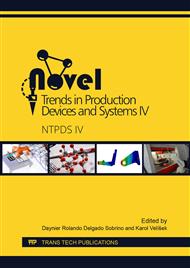[1]
K. Velíšek, P. Košťál, F. Pecháček, Stroje a zariadenia pre špeciálne technológie. Bratislava: Vydavateľstvo STU (2006) ISBN 80-227-2364-9. (In Slovak).
Google Scholar
[2]
L. Sobotová, M. Karková, Kvalita rezacej vody pri technológií delenia materiálov vodným lúčom 2012 [online]. [cit.10.10.2016]. Available on internet (In Slovak): https://www.sjf.tuke.sk/transferinovacii/pages/archiv/transfer/24-2012/pdf/125-128.pdf.
Google Scholar
[3]
S. Hloch, J. Hlaváček, K. Vasilko, J. Cárach, I. Samardžić, D. Kozak, I. Hlavatý, J. J. Ščučka, J. Klich, D. Klichová, D., Abrasive waterjet (AWJ) titanium tangential turning evaluation. Metalurgija 53 (2014) p.537–540.
DOI: 10.1007/s00603-015-0719-9
Google Scholar
[4]
J. Cárach, S. Hloch, P. Hlaváček, J. Ščučka, P. Martinec, J. Petrů, T. Zlámal, M. Zeleňák, P. Monka, D. Lehocká, J. Krolczyk, 2016. Tangential turning of Incoloy alloy 925 using abrasive water jet technology, Int. J. Adv. Manuf. Technol.82 (2016).
DOI: 10.1007/s00170-015-7489-0
Google Scholar
[5]
F. Lissek, M. Kaufeld, J. Tegas, S. Hloch, 2016. Online -monitoring for abrasive waterjet cutting of CFRP via acoustic emission: Evaluation of machining parameters and work piece quality due to burst analysis. In: Procedia Engineering (2016).
DOI: 10.1016/j.proeng.2016.06.640
Google Scholar
[6]
M. Hashish, A. South, Optimization Factors in Abrasive - Waterjet Machining, J. Eng. Ind. 1, (1991).
Google Scholar
[7]
J. Wang, D. M. Guo, A predictive depth of penetration model for abrasive waterjet cutting of polymer matrix composites, J. of Mat. Proc. Tech. (2002) vol. 121, no. 2–3, p.390–394.
DOI: 10.1016/s0924-0136(01)01246-8
Google Scholar
[8]
P. Hreha, A. Radvanská, S. Hloch, V. Peržel, G. Królczyk, K. Monková, Determination of vibration frequency depending on abrasive mass flow rate during abrasive water jet cutting. Int. J. Adv. Manuf. Technol. 77 (2015) p.763–774.
DOI: 10.1007/s00170-014-6497-9
Google Scholar
[9]
R. Kumar, S. Chattopadhyaya, A. R. Dixit, B. Bora, M. Zelenak, M., J. Foldyna, S. Hloch, P. Hlavacek, J. Scucka, J. Klich, L. Sitek, P. Vilaca, Surface integrity analysis of abrasive water jet - cut surfaces of friction stir welded joints. (2017).
DOI: 10.1007/s00170-016-8776-0
Google Scholar
[10]
M. Srivastava, R. Tripathi, S. Hloch, S. Chattopadhyaya, A. R. Dixit, Potential of using water jet peening as a surface treatment process for welded joints. In: Procedia Engineering (2016) p.472–480.
DOI: 10.1016/j.proeng.2016.06.694
Google Scholar
[11]
S. Hloch, M. Gombar, A. Radvanská, Non-linear modelling and evaluation of pressure and traverse rate influence to acoustic sound pressure level at abrasive waterjet machining. Int. J. Autom. Control 1, (2007).
DOI: 10.1504/ijaac.2007.014019
Google Scholar
[12]
B. Jurisevic, D. Brissaud, M. Junkar, Monitoring of abrasive water jet (AWJ) cutting using sound detection. Int. J. Adv. Manuf. Technol. 24 (2004) 733–737.
DOI: 10.1007/s00170-003-1752-5
Google Scholar
[13]
A. W. Momber, R. Kovacevic, Principles of Abrasive Water Jet Machining. London: Springer –Verlag, (1998).
DOI: 10.1007/978-1-4471-1572-4
Google Scholar
[14]
M. K. Kulekci, Processes and apparatus developments in industrial waterjet applications. Int. J. Mach. Tools Manuf. 42 (2002) p.1297–1306.
DOI: 10.1016/s0890-6955(02)00069-x
Google Scholar
[15]
S. Hloch, J. Valíček, Topographical anomaly on surfaces created by abrasive waterjet. Int. J. Adv. Manuf. Technol. 59 (2012) p.593–604.
DOI: 10.1007/s00170-011-3511-3
Google Scholar
[16]
A. Mičietová. Nekonvenčné metódy obrábania. Žilina: Vydavateľstvo ŽU, (2001). (In Slovak).
Google Scholar


